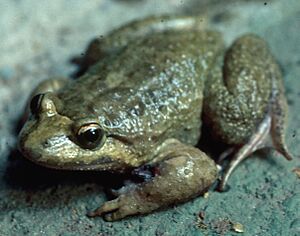Corsican painted frog facts for kids
Quick facts for kids Corsican painted frog |
|
|---|---|
 |
|
| Conservation status | |
| Scientific classification |
The Corsican painted frog (Discoglossus montalentii) is a special type of frog. It belongs to a family called Alytidae. This frog is found only on the beautiful French island of Corsica. It loves living in cool forests and near rivers.
What Does the Corsican Painted Frog Look Like?
The Corsican painted frog looks a lot like another frog, the Tyrrhenian painted frog. But there are a few ways to tell them apart! The Corsican painted frog has a snout that is more rounded. Its back is also flatter.
Its front foot has a fourth finger that gets thinner at the end, instead of being flat like a spatula. Its back legs are longer too. This frog can grow to be about 6.5 centimetres (2.6 in) long.
Their color can be plain brown, grey, or reddish-brown. Some even have dark brown spots. Their belly is usually a pale color. When this frog calls, it sounds like a musical "poop – poop – poop." It's a different sound from other painted frogs!
Where Does the Corsican Painted Frog Live?
This frog is only found on the island of Corsica. This means it is endemic to Corsica. You can mostly find it in the central parts of the island. It lives at high places, from about 300 to 1,900 metres (980 to 6,230 ft) above sea level.
It especially likes mountain streams and other water spots in woods and forests. The Corsican painted frog shares its home with the Tyrrhenian painted frog ((Discoglossus sardus)). However, the Corsican painted frog prefers higher mountains. It is very good at jumping from rock to rock!
What Do Corsican Painted Frogs Eat and How Do They Live?
Like other frogs in its family, the Corsican painted frog eats small invertebrates. These are tiny creatures without backbones, like insects.
For a long time, scientists found it hard to tell the Corsican painted frog apart from the Tyrrhenian painted frog. They look so similar! It wasn't until the late 1900s that they were officially recognized as different species. Because of this, we don't know everything about how they reproduce.
However, scientists believe these frogs lay their eggs in small groups. They might also lay them one by one on the bottom of streams. The eggs are brownish-black and about 1 to 1.5 millimetres (0.039 to 0.059 in) wide. They are covered in a thick, jelly-like layer.


